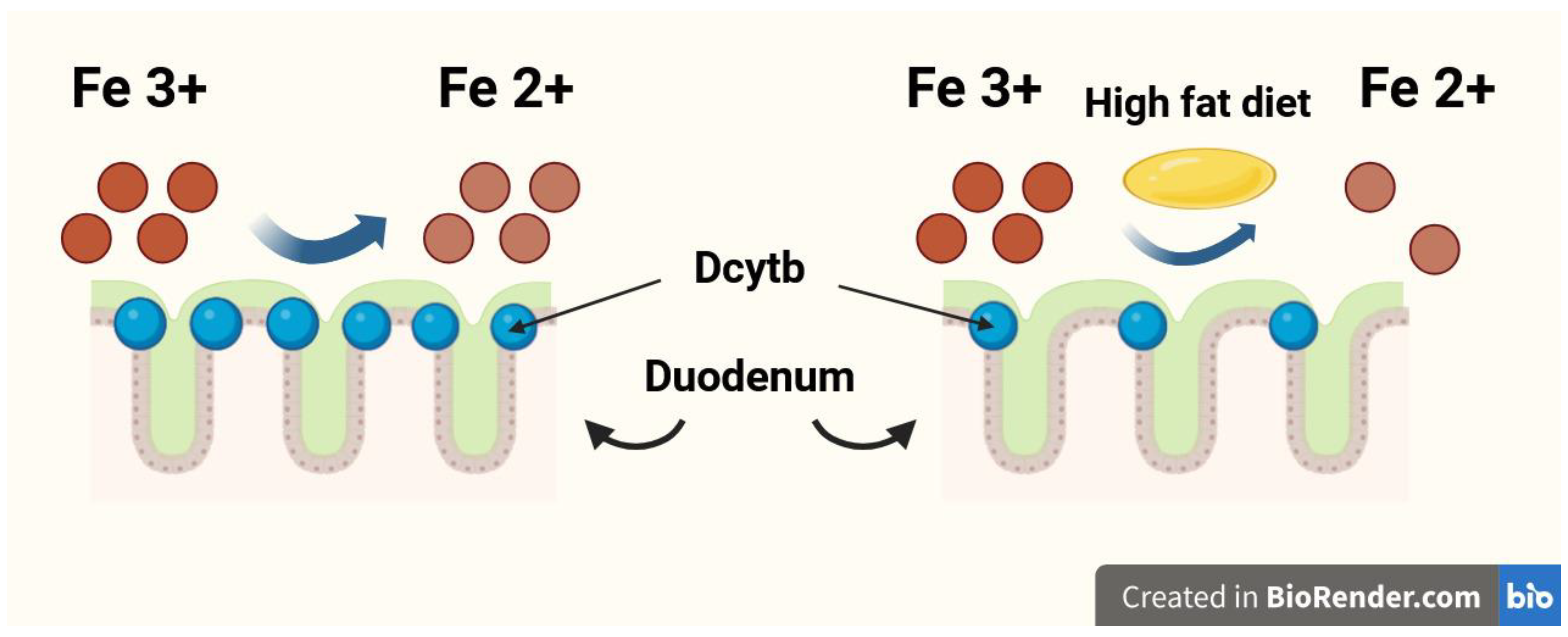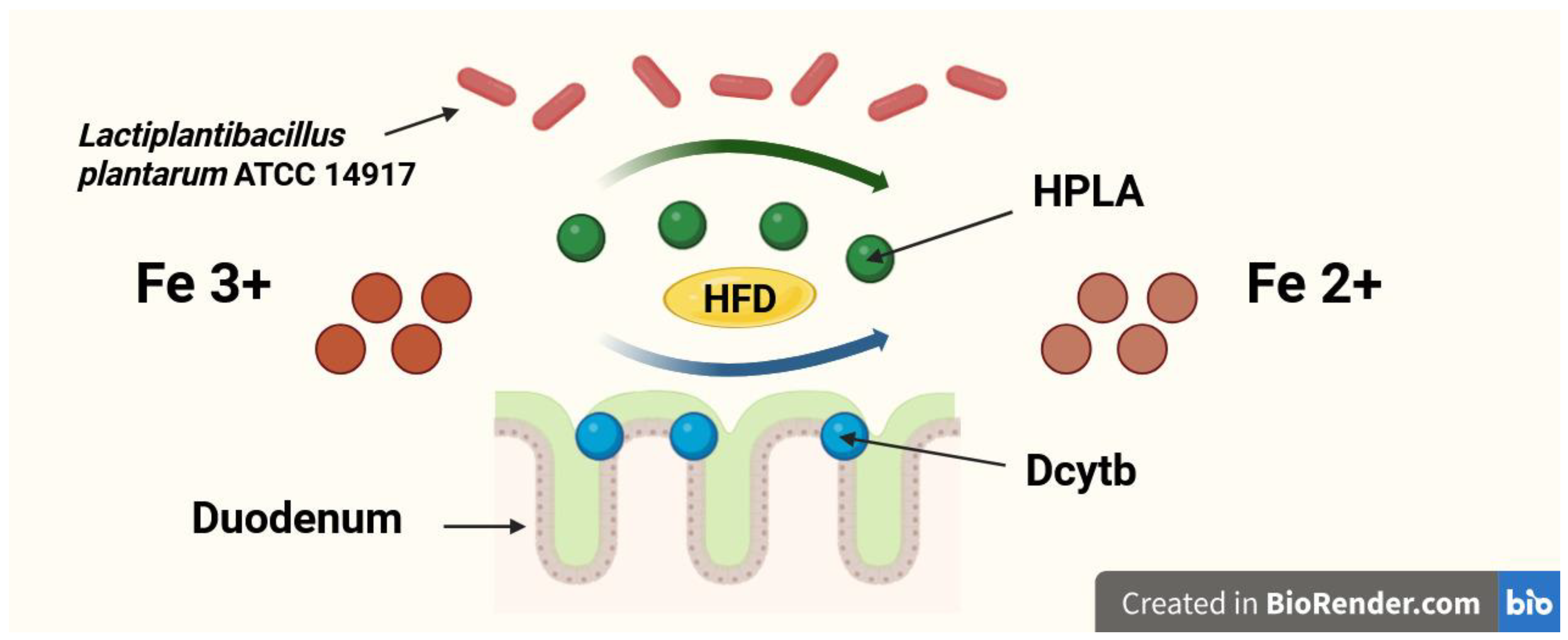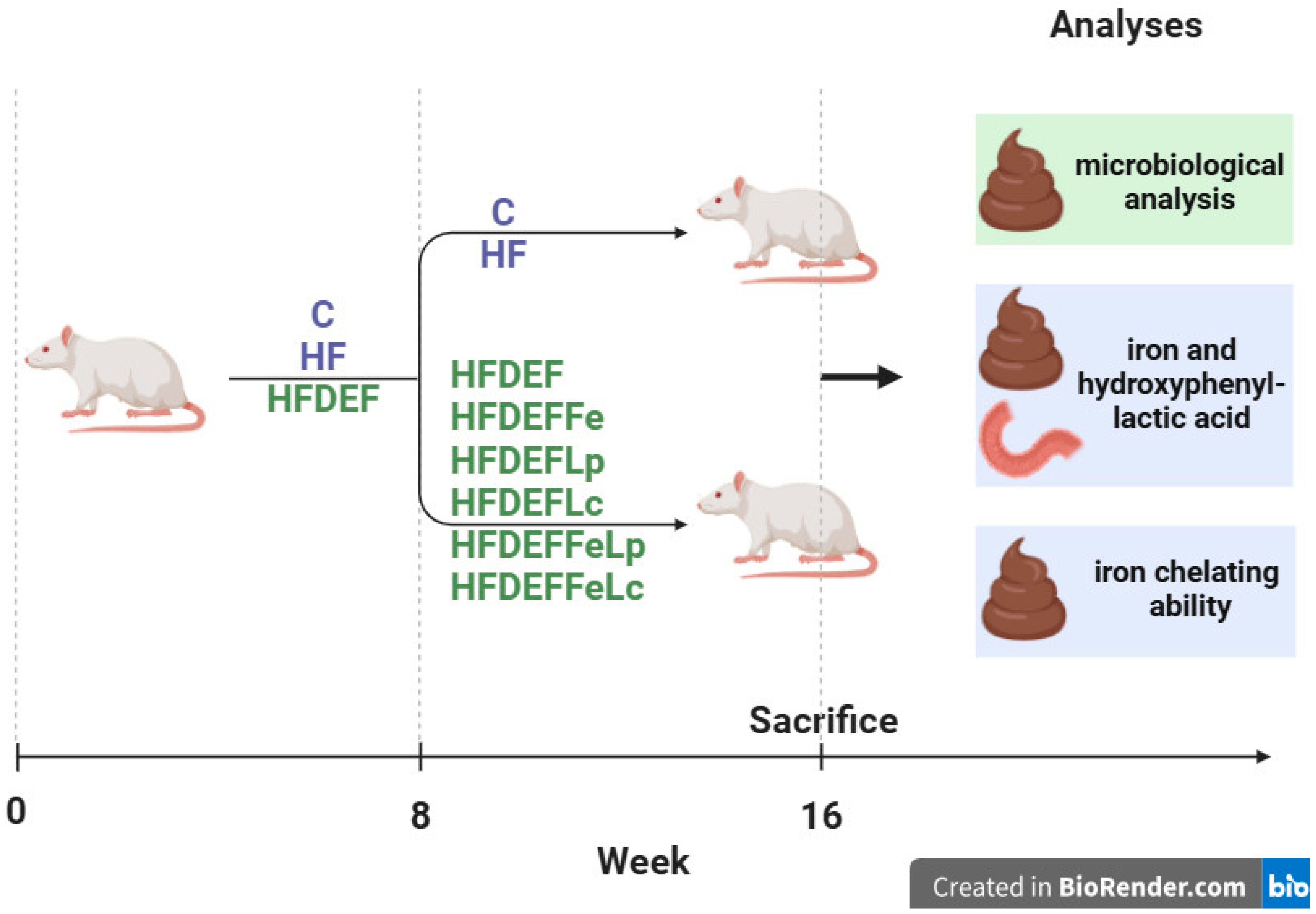Lactiplantibacillus plantarum, Duodenal Hydroxyphenyllactic Acid and Iron: Insights from a Rat Model of a High-Fat Iron-Deficient Diet
Abstract
1. Introduction
2. Materials and Methods
2.1. Study Design
- HFDEF subgroup: Continued on the high-fat, Fe-deficient diet from the first stage.
- HFDEFFe subgroup: Fed a high-fat, Fe-deficient diet supplemented with Fe in the form of Fe gluconate (120 mg Fe/kg diet).
- HFDEFLp subgroup: Fed a high-fat, Fe-deficient diet with the probiotic Lactiplantibacillus plantarum (daily dose: 5 × 109 colony-forming units [CFU]).
- HFDEFLc subgroup: Fed a high-fat, Fe-deficient diet with the probiotic Latilactobacillus curvatus (daily dose: 5 × 109 CFU).
- HFDEFFeLp subgroup: Fed a high-fat, Fe-deficient diet with Lactiplantibacillus plantarum (daily dose: 5 × 109 CFU) and Fe supplementation (Fe gluconate; 120 mg Fe/kg diet).
- HFDEFFeLc subgroup: Fed a high-fat, Fe-deficient diet with Latilactobacillus curvatus (daily dose: 5 × 109 CFU) and Fe supplementation (Fe gluconate; 120 mg Fe/kg diet).
2.2. Study Animals
2.3. Diet
2.4. Probiotics
2.5. Duodenum and Faeces Collection and Preparation
2.6. Faecal Microbiological Analysis
2.7. Fe and HPLA Content Determination
- C group: 38.373 mg Fe/kg;
- HF group: 55.593 mg Fe/kg;
- HFDEF, HFDEFLp, and HFDEFLc subgroups: 27.645 mg Fe/kg;
- HFDEFFe, HFDEFFeLp, and HFDEFFeLc subgroups: 177.632 mg Fe/kg.
2.8. Determination of Fe Chelating Ability
2.9. Statistical Analysis
3. Results
4. Discussion
4.1. HPLA Content in Duodenum and Faeces and Fe Chelating Ability
4.2. Fe Content in Duodenum and Faeces
4.3. Bacterial Content in Faeces
5. Study Strengths
6. Study Limitations
7. Further Investigations
8. Clinical Implications
9. Conclusions
Supplementary Materials
Author Contributions
Funding
Institutional Review Board Statement
Informed Consent Statement
Data Availability Statement
Conflicts of Interest
References
- Lee, S.; Son, Y.; Hwang, J.; Kim, M.S.; McLaughlin, S.A.; Vilchis-Tella, V.; Zoeckler, L.; Perumal, N.; Zyoud, S.H.; Zoghi, G.; et al. Global, Regional and National Burden of Dietary Iron Deficiency from 1990 to 2021: A Global Burden of Disease Study. Nat. Med. 2025, 31, 1809–1829. [Google Scholar] [CrossRef] [PubMed]
- Wang, L.; Wang, H.; Zhang, B.; Popkin, B.M.; Du, S. Elevated Fat Intake Increases Body Weight and the Risk of Overweight and Obesity among Chinese Adults: 1991-2015 Trends. Nutrients 2020, 12, 3272. [Google Scholar] [CrossRef] [PubMed]
- Song, S.; Shim, J.E. Trends in Dietary Intake of Total Fat and Fatty Acids among Korean Adolescents from 2007 to 2017. Nutrients 2019, 11, 3073. [Google Scholar] [CrossRef] [PubMed]
- Song, S.; Shim, J.E. Increasing Trends in Dietary Total Fat and Fatty Acid Intake among Korean Children: Using the 2007–2017 National Data. Nutr. Res. Pract. 2022, 16, 260–271. [Google Scholar] [CrossRef]
- Rombaldi, A.J.; da Silva, M.C.; Neutzling, M.B.; Azevedo, M.R.; Hallal, P.C. Fatores Associados Ao Consumo de Dietas Ricas Em Gordura Em Adultos de Uma Cidade No Sul Do Brasil. Cienc. Saude Coletiva 2014, 19, 1513–1521. [Google Scholar] [CrossRef]
- Ebrahimi, S.; Leech, R.M.; McNaughton, S.A.; Farzadfar, F.; Ghasemi, E.; Saeedi Moghaddam, S.; Livingstone, K.M. Sociodemographic Differences in Dietary Trends among Iranian Adults: Findings from the 2005-2016 Iran-WHO STEPS Survey. Public Health Nutr. 2023, 26, 2963–2972. [Google Scholar] [CrossRef]
- Rakhra, V.; Galappaththy, S.L.; Bulchandani, S.; Cabandugama, P.K. Obesity and the Western Diet: How We Got Here. Mo. Med. 2020, 117, 536. [Google Scholar]
- Rice Bradley, B.H. Dietary Fat and Risk for Type 2 Diabetes: A Review of Recent Research. Curr. Nutr. Rep. 2018, 7, 214–226. [Google Scholar] [CrossRef]
- Choi, J.; Masaratana, P.; Latunde-Dada, G.O.; Arno, M.; Simpson, R.J.; McKie, A.T. Duodenal Reductase Activity and Spleen Iron Stores Are Reduced and Erythropoiesis Is Abnormal in Dcytb Knockout Mice Exposed to Hypoxic Conditions. J. Nutr. 2012, 142, 1929–1934. [Google Scholar] [CrossRef]
- Gunshin, H.; Mackenzie, B.; Berger, U.V.; Gunshin, Y.; Romero, M.F.; Boron, W.F.; Nussberger, S.; Gollan, J.L.; Hediger, M.A. Cloning and Characterization of a Mammalian Proton-Coupled Metal-Ion Transporter. Nature 1997, 388, 482–488. [Google Scholar] [CrossRef]
- Aigner, E.; Feldman, A.; Datz, C. Obesity as an Emerging Risk Factor for Iron Deficiency. Nutrients 2014, 6, 3587–3600. [Google Scholar] [CrossRef]
- Sonnweber, T.; Ress, C.; Nairz, M.; Theurl, I.; Schroll, A.; Murphy, A.T.; Wroblewski, V.; Witcher, D.R.; Moser, P.; Ebenbichler, C.F.; et al. High-Fat Diet Causes Iron Deficiency via Hepcidin-Independent Reduction of Duodenal Iron Absorption. J. Nutr. Biochem. 2012, 23, 1600–1608. [Google Scholar] [CrossRef]
- Silva, B.; Faustino, P. An Overview of Molecular Basis of Iron Metabolism Regulation and the Associated Pathologies. Biochim. Biophys. Acta (BBA)—Mol. Basis Dis. 2015, 1852, 1347–1359. [Google Scholar] [CrossRef]
- Saha, P.; Yeoh, B.S.; Singh, R.; Chandrasekar, B.; Vemula, P.K.; Haribabu, B.; Vijay-Kumar, M.; Jala, V.R. Gut Microbiota Conversion of Dietary Ellagic Acid into Bioactive Phytoceutical Urolithin A Inhibits Heme Peroxidases. PLoS ONE 2016, 11, e0156811. [Google Scholar] [CrossRef]
- Yilmaz, B.; Li, H. Gut Microbiota and Iron: The Crucial Actors in Health and Disease. Pharmaceuticals 2018, 11, 98. [Google Scholar] [CrossRef] [PubMed]
- Vonderheid, S.C.; Tussing-Humphreys, L.; Park, C.; Pauls, H.; Hemphill, N.O.; Labomascus, B.; McLeod, A.; Koenig, M.D. A Systematic Review and Meta-Analysis on the Effects of Probiotic Species on Iron Absorption and Iron Status. Nutrients 2019, 11, 2938. [Google Scholar] [CrossRef] [PubMed]
- González, A.; Gálvez, N.; Martín, J.; Reyes, F.; Pérez-Victoria, I.; Dominguez-Vera, J.M. Identification of the Key Excreted Molecule by Lactobacillus fermentum Related to Host Iron Absorption. Food Chem. 2017, 228, 374–380. [Google Scholar] [CrossRef] [PubMed]
- Suzuki, Y.; Kosaka, M.; Shindo, K.; Kawasumi, T.; Kimoto-Nira, H.; Suzuki, C. Identification of Antioxidants Produced by Lactobacillus plantarum. Biosci. Biotechnol. Biochem. 2013, 77, 1299–1302. [Google Scholar] [CrossRef]
- Shehata, A.I.; Soliman, A.A.; Ahmed, H.A.; Gewaily, M.S.; Amer, A.A.; Shukry, M.; Abdel-Latif, H.M.R. Evaluation of Different Probiotics on Growth, Body Composition, Antioxidant Capacity, and Histoarchitecture of Mugil Capito. Sci. Rep. 2024, 14, 7379. [Google Scholar] [CrossRef]
- Scarano, A.; Laddomada, B.; Blando, F.; De Santis, S.; Verna, G.; Chieppa, M.; Santino, A. The Chelating Ability of Plant Polyphenols Can Affect Iron Homeostasis and Gut Microbiota. Antioxidants 2023, 12, 630. [Google Scholar] [CrossRef]
- Wang, X.; Li, Y.; Han, L.; Li, J.; Liu, C.; Sun, C. Role of Flavonoids in the Treatment of Iron Overload. Front. Cell Dev. Biol. 2021, 9, 685364. [Google Scholar] [CrossRef]
- Pandey, A.; Bringel, F.; Meyer, J.-M. Iron Requirement and Search for Siderophores in Lactic Acid Bacteria. Appl. Microbiol. Biotechnol. 1994, 40, 735–739. [Google Scholar] [CrossRef]
- Skrypnik, K.; Olejnik-Schmidt, A.; Mikołajczyk-Stecyna, J.; Schmidt, M.; Suliburska, J. Influence of Supplementation of Probiotic Bacteria Lactobacillus plantarum and Lactobacillus curvatus on Selected Parameters of Liver Iron Metabolism in Rats on High-Fat Iron-Deficient Diet. J. Funct. Foods 2022, 96, 105205. [Google Scholar] [CrossRef]
- Skrypnik, K.; Schmidt, M.; Olejnik-Schmidt, A.; Harahap, I.A.; Suliburska, J. Influence of Supplementation with Iron and Probiotic Bacteria Lactobacillus plantarum and Lactobacillus curvatus on Selected Parameters of Inflammatory State in Rats on a High-Fat Iron-Deficient Diet. J. Sci. Food Agric. 2024, 104, 4411–4424. [Google Scholar] [CrossRef] [PubMed]
- Skrypnik, K.; Olejnik-Schmidt, A.; Mikołajczyk-Stecyna, J.; Schmidt, M.; Suliburska, J. Influence of Supplementation with Probiotic Bacteria Lactiplantibacillus plantarum and Latilactobacillus curvatus on Selected Parameters of Duodenum Iron Metabolism in Rats on a High-Fat Iron-Deficient Diet. Nutrition 2024, 129, 112591. [Google Scholar] [CrossRef]
- Apaijai, N.; Arinno, A.; Palee, S.; Pratchayasakul, W.; Kerdphoo, S.; Jaiwongkam, T.; Chunchai, T.; Chattipakorn, S.C.; Chattipakorn, N. High-Saturated Fat High-Sugar Diet Accelerates Left-Ventricular Dysfunction Faster than High-Saturated Fat Diet Alone via Increasing Oxidative Stress and Apoptosis in Obese-Insulin Resistant Rats. Mol. Nutr. Food Res. 2019, 63, 1800729. [Google Scholar] [CrossRef]
- Luo, D.; Liu, L.; Liang, F.; Yu, Z.; Chen, R. Electroacupuncture: A Feasible Sirt1 Promoter Which Modulates Metainflammation in Diet-Induced Obesity Rats. Evid.-Based Complement. Altern. Med. 2018, 2018, 5302049. [Google Scholar] [CrossRef]
- Buettner, R.; Schölmerich, J.; Bollheimer, L.C. High-Fat Diets: Modeling the Metabolic Disorders of Human Obesity in Rodents. Obesity 2007, 15, 798–808. [Google Scholar] [CrossRef]
- Liu, C.; Zhou, M.-S.; Li, Y.; Wang, A.; Chadipiralla, K.; Tian, R.; Raij, L. Oral Nicotine Aggravates Endothelial Dysfunction and Vascular Inflammation in Diet-Induced Obese Rats: Role of Macrophage TNFα. PLoS ONE 2017, 12, e0188439. [Google Scholar] [CrossRef]
- Regula, J.; Krejpcio, Z.; Staniek, H. Bioavailability of Iron from Cereal Products Enriched with Dried Shittake Mushrooms (Lentinula edodes) as Determined by Iron Regeneration Efficacy Method in Female Rats. J. Med. Food 2010, 13, 1189–1194. [Google Scholar] [CrossRef]
- Kamei, A.; Watanabe, Y.; Ishijima, T.; Uehara, M.; Arai, S.; Kato, H.; Nakai, Y.; Abe, K. Dietary Iron-Deficient Anemia Induces a Variety of Metabolic Changes and Even Apoptosis in Rat Liver: A DNA Microarray Study. Physiol. Genom. 2010, 42, 149–156. [Google Scholar] [CrossRef]
- Kamei, A.; Watanabe, Y.; Kondo, K.; Okada, S.; Shinozaki, F.; Ishijima, T.; Nakai, Y.; Kondo, T.; Arai, S.; Abe, K. Influence of a Short-Term Iron-Deficient Diet on Hepatic Gene Expression Profiles in Rats. PLoS ONE 2013, 8, e65732. [Google Scholar] [CrossRef] [PubMed]
- AIN-93M | Zeigler—Nutrition Through Innovation. Available online: http://www.zeiglerfeed.com/research-diets/ain-93m/ (accessed on 14 August 2018).
- Bristow-Craig, H.E.; Strain, J.J.; Welch, R.W. Iron Status, Blood Lipids and Endogenous Antioxidants in Response to Dietary Iron Levels in Male and Female Rats. Int. J. Vitam. Nutr. Res. 1994, 64, 324–329. [Google Scholar]
- Rivest, R.W. Sexual Maturation in Female Rats: Hereditary, Developmental and Environmental Aspects. Experientia 1991, 47, 1026–1038. [Google Scholar] [CrossRef] [PubMed]
- Sturm, R.; Ringel, J.S.; Andreyeva, T. Increasing Obesity Rates and Disability Trends. Health Aff. 2004, 23, 199–205. [Google Scholar] [CrossRef] [PubMed]
- Guja, H.; Baye, K. Extrinsic Iron from Soil Contributes to Hb Regeneration of Anaemic Rats: Implications for Foods Contaminated with Soil Iron. Br. J. Nutr. 2018, 119, 880–886. [Google Scholar] [CrossRef]
- Skrypnik, K.; Bogdanski, P.; Loniewski, I.; Regula, J.; Suliburska, J. Effect of Probiotic Supplementation on Liver Function and Lipid Status in Rats. Acta Sci. Pol. Technol. Aliment. 2018, 17, 185–192. [Google Scholar] [CrossRef]
- Deschemin, J.-C.; Noordine, M.-L.; Remot, A.; Willemetz, A.; Afif, C.; Canonne-Hergaux, F.; Langella, P.; Karim, Z.; Vaulont, S.; Thomas, M.; et al. The Microbiota Shifts the Iron Sensing of Intestinal Cells. FASEB J. 2016, 30, 252–261. [Google Scholar] [CrossRef]
- Laparra, J.M.; Olivares, M.; Sanz, Y. Oral Administration of Bifidobacterium longum CECT 7347 Ameliorates Gliadin-Induced Alterations in Liver Iron Mobilisation. Br. J. Nutr. 2013, 110, 1828–1836. [Google Scholar] [CrossRef]
- Choi, I.-D.; Kim, S.-H.; Jeong, J.-W.; Lee, D.E.; Huh, C.-S.; Hong, S.S.; Sim, J.-H.; Ahn, Y.-T. Triglyceride-Lowering Effects of Two Probiotics, Lactobacillus plantarum KY1032 and Lactobacillus curvatus HY7601, in a Rat Model of High-Fat Diet-Induced Hypertriglyceridemia. J. Microbiol. Biotechnol. 2016, 26, 483–487. [Google Scholar] [CrossRef]
- Zeiner, M.; Zödl, B.; Steffan, I.; Marktl, W.; Ekmekcioglu, C. Determination of Iron in Caco-2 Cells by ET-AAS. Anal. Bioanal. Chem. 2005, 382, 239–242. [Google Scholar] [CrossRef]
- Gruber, A.; Müller, R.; Wagner, A.; Colucci, S.; Spasić, M.V.; Leopold, K. Total Reflection X-Ray Fluorescence Spectrometry for Trace Determination of Iron and Some Additional Elements in Biological Samples. Anal. Bioanal. Chem. 2020, 412, 6419–6429. [Google Scholar] [CrossRef]
- Decker, E.A.; Welch, B. Role of Ferritin as a Lipid Oxidation Catalyst in Muscle Food. J. Agric. Food Chem. 1990, 38, 674–677. [Google Scholar] [CrossRef]
- Mendi, A.; Aslım, B. Antioxidant Lactobacilli Could Protect Gingival Fibroblasts Against Hydrogen Peroxide: A Preliminary In Vitro Study. Probiotics Antimicrob. Proteins 2014, 6, 157–164. [Google Scholar] [CrossRef] [PubMed]
- Tian, Y.; Wang, Y.; Zhang, N.; Xiao, M.; Zhang, J.; Xing, X.; Zhang, Y.; Fan, Y.; Li, X.; Nan, B.; et al. Antioxidant Mechanism of Lactiplantibacillus plantarum KM1 Under H2O2 Stress by Proteomics Analysis. Front. Microbiol. 2022, 13, 897387. [Google Scholar] [CrossRef] [PubMed]
- Cuisiniere, T.; Hajjar, R.; Oliero, M.; Calvé, A.; Fragoso, G.; Rendos, H.V.; Gerkins, C.; Taleb, N.; Gagnon-Konamna, M.; Dagbert, F.; et al. Initial Gut Microbiota Composition Is a Determining Factor in the Promotion of Colorectal Cancer by Oral Iron Supplementation: Evidence from a Murine Model. Microbiome 2025, 13, 100. [Google Scholar] [CrossRef]
- Muller, E.; Algavi, Y.M.; Borenstein, E. The Gut Microbiome-Metabolome Dataset Collection: A Curated Resource for Integrative Meta-Analysis. NPJ Biofilms Microbiomes 2022, 8, 79. [Google Scholar] [CrossRef]
- Blachier, F.; Vaugelade, P.; Robert, V.; Kibangou, B.; Canonne-Hergaux, F.; Delpal, S.; Bureau, F.; Blottière, H.; Bouglé, D. Comparative Capacities of the Pig Colon and Duodenum for Luminal Iron Absorption. Can. J. Physiol. Pharmacol. 2007, 85, 185–192. [Google Scholar] [CrossRef]
- Minor, E.A.; Kupec, J.T.; Nickerson, A.J.; Narayanan, K.; Rajendran, V.M. Increased DMT1 and FPN1 Expression with Enhanced Iron Absorption in Ulcerative Colitis Human Colon. Am. J. Physiol. Cell Physiol. 2020, 318, C263–C271. [Google Scholar] [CrossRef]
- Rinninella, E.; Cintoni, M.; Raoul, P.; Ianiro, G.; Laterza, L.; Ponziani, F.R.; Pulcini, G.; Gasbarrini, A.; Mele, M.C. Diet-Induced Alterations in Gut Microbiota Composition and Function. Compr. Gut Microbiota 2022, 1, 354–373. [Google Scholar] [CrossRef]
- Guerville, M.; Boudry, G. Gastrointestinal and Hepatic Mechanisms Limiting Entry and Dissemination of Lipopolysaccharide into the Systemic Circulation. Am. J. Physiol. Gastrointest. Liver Physiol. 2016, 311, G1–G15. [Google Scholar] [CrossRef]
- Moya-Pérez, A.; Neef, A.; Sanz, Y. Bifidobacterium pseudocatenulatum CECT 7765 Reduces Obesity-Associated Inflammation by Restoring the Lymphocyte-Macrophage Balance and Gut Microbiota Structure in High-Fat Diet-Fed Mice. PLoS ONE 2015, 10, e0126976. [Google Scholar] [CrossRef]



| Group | n | HPLA Content (µg/g) | |
|---|---|---|---|
| Duodenum | Faeces | ||
| C | 8 | 27.94 ± 14.05 | 18.41 ± 2.84 |
| HF | 8 | 27.79 ± 16.38 | 18.50 ± 2.60 |
| HFDEF | 8 | 25.90 ± 3.10 | 19.45 ± 1.36 |
| HFDEFFe | 8 | 32.39 ± 16.90 | 18.61 ± 2.19 |
| HFDEFLp | 8 | 31.69 ± 22.33 | 18.54 ± 2.98 |
| HFDEFLc | 8 | 24.74 ± 6.10 | 20.54 ± 2.20 |
| HFDEFFeLp | 8 | 22.90 ± 12.00 | 18.82 ± 2.21 |
| HFDEFFeLc | 8 | 29.68 ± 10.68 | 21.54 ± 4.07 |
| Group | n | Fe Chelating Ability |
|---|---|---|
| C | 8 | 33.0 ± 16.2 |
| HF | 8 | 133.4 ± 97.9 |
| HFDEF | 8 | 333.8 ± 151.6 |
| HFDEFFe | 8 | 414.5 ± 359.7 |
| HFDEFLp | 8 | 72.1 ± 31.4 |
| HFDEFLc | 8 | 75.2 ± 53.6 |
| HFDEFFeLp | 8 | 378.4 ± 514.7 |
| HFDEFFeLc | 8 | 345.9 ± 386.5 |
| Group | Duodenal Fe Content (µg/g) |
|---|---|
| C | 124.51 ± 50.40 acd |
| HF | 141.05 ± 59.69 acd |
| HFDEF | 110.49 ± 16.46 ac |
| HFDEFFe | 247.06 ± 47.61 de |
| HFDEFLp | 170.75 ± 79.84 ad |
| HFDEFLc | 183.70 ± 63.42 ad |
| HFDEFFeLp | 332.79 ± 108.39 be |
| HFDEFFeLc | 293.23 ± 62.85 be |
| Group | Faecal Fe Content (µg/g) |
|---|---|
| C | 365.9 ± 105.0 ab |
| HF | 251.5 ± 42.4 ab |
| HFDEF | 55.1 ± 30.7 a |
| HFDEFFe | 752.3 ± 302.6 c |
| HFDEFLp | 140.7 ± 33.8 ab |
| HFDEFLc | 62.6 ± 22.2 a |
| HFDEFFeLp | 431.4 ± 89.1 bc |
| HFDEFFeLc | 519.3 ± 254.4 bc |
| Group | n | Total Faecal Bacterial Content (T) | Lactobacilli Faecal Content (Lb) |
|---|---|---|---|
| C | 8 | 9.65 ± 0.24 c | 8.49 ± 0.22 c |
| HF | 8 | 8.98 ± 0.08 abc | 7.89 ± 0.29 ab |
| HFDEF | 8 | 8.79 ± 0.49 ab | 7.47 ± 0.20 a |
| HFDEFFe | 8 | 8.65 ± 0.71 ab | 7.54 ± 0.48 a |
| HFDEFLp | 8 | 9.16 ± 0.22 bc | 8.16 ± 0.22 bc |
| HFDEFLc | 8 | 9.01 ± 0.49 abc | 8.22 ± 0.38 bc |
| HFDEFFeLp | 8 | 8.94 ± 0.87 abc | 7.66 ± 0.49 ab |
| HFDEFFeLc | 8 | 8.31 ± 0.55 a | 7.57 ± 0.44 a |
Disclaimer/Publisher’s Note: The statements, opinions and data contained in all publications are solely those of the individual author(s) and contributor(s) and not of MDPI and/or the editor(s). MDPI and/or the editor(s) disclaim responsibility for any injury to people or property resulting from any ideas, methods, instructions or products referred to in the content. |
© 2025 by the authors. Licensee MDPI, Basel, Switzerland. This article is an open access article distributed under the terms and conditions of the Creative Commons Attribution (CC BY) license (https://creativecommons.org/licenses/by/4.0/).
Share and Cite
Skrypnik, K.; Olejnik-Schmidt, A.; Schmidt, M.; Selvan, D.; Suliburska, J. Lactiplantibacillus plantarum, Duodenal Hydroxyphenyllactic Acid and Iron: Insights from a Rat Model of a High-Fat Iron-Deficient Diet. Nutrients 2025, 17, 3454. https://doi.org/10.3390/nu17213454
Skrypnik K, Olejnik-Schmidt A, Schmidt M, Selvan D, Suliburska J. Lactiplantibacillus plantarum, Duodenal Hydroxyphenyllactic Acid and Iron: Insights from a Rat Model of a High-Fat Iron-Deficient Diet. Nutrients. 2025; 17(21):3454. https://doi.org/10.3390/nu17213454
Chicago/Turabian StyleSkrypnik, Katarzyna, Agnieszka Olejnik-Schmidt, Marcin Schmidt, Damla Selvan, and Joanna Suliburska. 2025. "Lactiplantibacillus plantarum, Duodenal Hydroxyphenyllactic Acid and Iron: Insights from a Rat Model of a High-Fat Iron-Deficient Diet" Nutrients 17, no. 21: 3454. https://doi.org/10.3390/nu17213454
APA StyleSkrypnik, K., Olejnik-Schmidt, A., Schmidt, M., Selvan, D., & Suliburska, J. (2025). Lactiplantibacillus plantarum, Duodenal Hydroxyphenyllactic Acid and Iron: Insights from a Rat Model of a High-Fat Iron-Deficient Diet. Nutrients, 17(21), 3454. https://doi.org/10.3390/nu17213454









